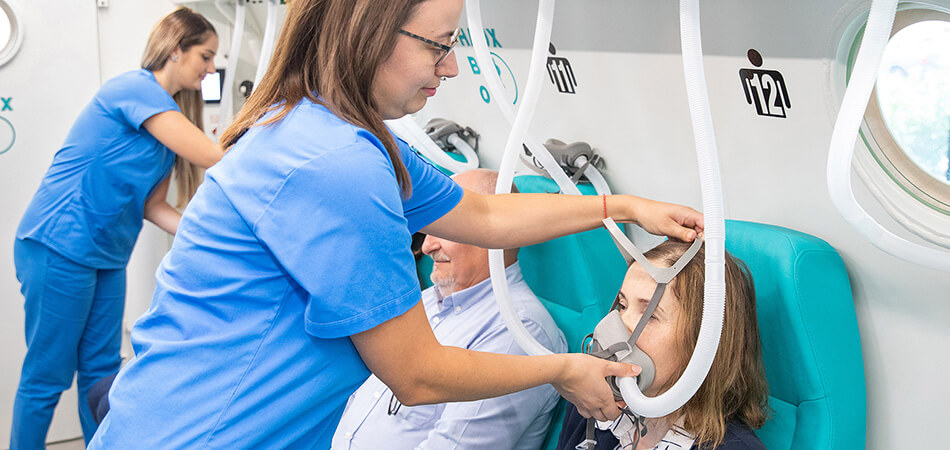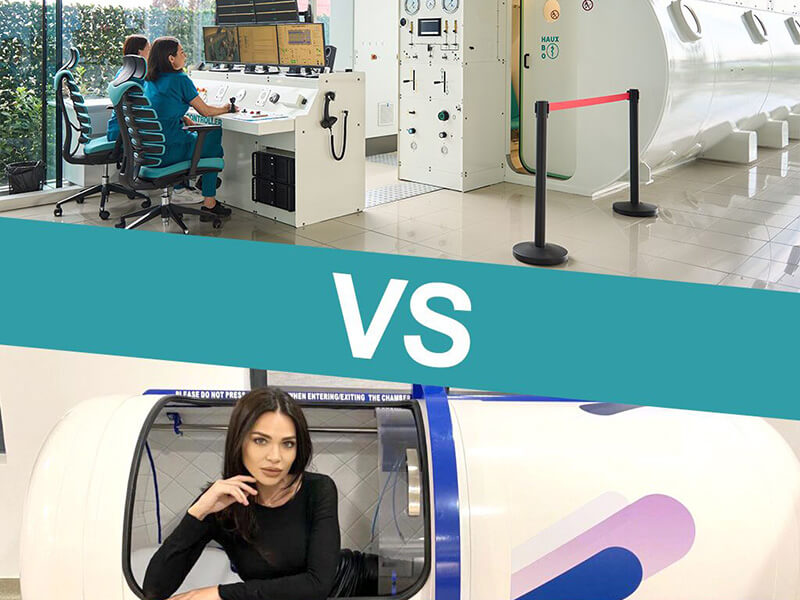
Article reviewed by: Dr. Sturz Ciprian, Dr. Tîlvescu Cătălin and Dr. Alina Vasile
Physiological Effects of Hyperbaric Therapy
In hyperbaric therapy, the physiological effects refer to the beneficial changes that occur in your body when you inhale pure oxygen in a hyperbaric environment, i.e. with increased pressure. Basically, the body receives more oxygen than usual, which helps to heal wounds faster, fight infection and reduce inflammation. It's like giving your body a "charge session" with oxygen, which improves the functioning of every organ and system in the body. Among the physiological effects of hyperbaric therapy are:
1) Increased oxygenation
Increased oxygenation is a physiological effect that refers to the enrichment of blood and tissues with oxygen to higher than usual levels. Under conditions of increased pressure, the blood can carry a larger amount of oxygen than under normal conditions. This extra oxygen dissolves in the blood plasma and is carried to the tissues of the body, even in areas where blood circulation is restricted or compromised. By increasing the availability of oxygen, hyperbaric therapy supports vital functions of the body, significantly contributing to the improvement of general health.
2) Stimulation of angiogenesis
Stimulation of angiogenesis is a physiological effect that involves the formation of new blood vessels in body tissues. This response to hyperbaric therapy is crucial for wound healing and tissue regeneration, providing an increased supply of essential oxygen and nutrients to affected areas. Thus, the effectiveness of treatment for various conditions, from chronic conditions to acute injuries, is significantly improved, contributing to a faster and more complete recovery.
3) Modulation of the inflammatory response
This is a physiological effect that involves adjusting the body's inflammatory processes. In hyperbaric therapy, this helps alleviate excessive inflammation, helping to prevent tissue damage and facilitating a more favorable healing environment. Through this modulation, hyperbaric therapy can reduce the risk of complications associated with chronic inflammation, such as fibrosis or scarring, thus facilitating a more efficient and faster recovery of affected tissues.
4) Fighting infections
Hyperbaric therapy can stimulate the production of white blood cells, especially neutrophils and lymphocytes, giving the body a more robust line of defense against infection. Neutrophils, activated by hyperbaric oxygen, become more effective at fighting bacteria and other microorganisms, while B lymphocytes produce more antibodies to neutralize toxins. This leads to a reduction in the length of hospital stay, decreasing the risk of sepsis, accelerating the healing of chronic wounds and improving the response to antimicrobial treatments.
5) Improving cognitive function
Hyperbaric therapy can improve cognitive function by increasing cerebral blood flow and through microstructural changes in the brain, especially in the frontal, parietal and limbic regions, which are associated with cognitive and mental functions. These improvements include attention, executive function, and psychiatric symptoms such as depression and anxiety. This indicates significant potential for hyperbaric therapy in improving cognitive and mental health, especially after conditions such as COVID-19.
6) Speeding up wound healing
Hyperbaric therapy helps accelerate wound healing through several mechanisms. One of these is decreasing active levels of an enzyme called matrix metalloproteinase-9 (MMP-9), which is responsible for slowing the healing process in diabetic ulcers. Lowering these levels in injured tissues helps to enhance healing. In addition, hyperbaric oxygen treatment reduces levels of reactive oxygen species (ROS) in wounds, which is beneficial because ROS can impede the healing process.
7) Pain relief
Hyperbaric oxygen can help block the transmission of pain signals to the brain. This can help reduce the severity of pain and improve quality of life. Muscle spasm can be a major cause of pain, especially in conditions such as fibromyalgia or arthritis. Hyperbaric oxygen can help reduce muscle spasm by relaxing the muscles and improving blood flow to the affected area. Also, hyperbaric therapy can inhibit the effect of certain toxins or bacteria and can enhance the ability of white cells (leukocytes) to fight infections.
8) Reduction of oxidative stress
Hyperbaric oxygen can stimulate the production of endogenous antioxidants, which can help neutralize free radicals and protect cells from oxidative damage. Mitochondria are the cellular organisms responsible for energy production. Oxidative stress can damage mitochondria, reducing energy production and leading to cellular dysfunction. Hyperbaric oxygen can help improve mitochondrial function, increasing energy production and protecting cells from oxidative damage.
9) Stimulation of the immune system
Hyperbaric therapy acts as a stimulant for the immune system by providing an increased flow of oxygen to immune cells. This increased oxygen supply gives them extra energy to fight pathogens. In addition, hyperbaric therapy stimulates the production of white blood cells, especially neutrophils and lymphocytes, which are essential for fighting infections. Hyperbaric oxygen therapy can also help improve the function of stem cells, increasing their potential to transform into immune cells. These combined effects lead to a number of advantages, including reduced length of hospital stay, decreased risk of sepsis, accelerated healing of chronic wounds, and improved response to antimicrobial treatments.
10) Improving athletic performance
Increased blood flow to the brain promotes concentration, mood and alertness, giving athletes better coordination, faster decision-making and greater motivation during competitions. Muscles receive more oxygen, increasing cellular respiration and energy production, resulting in improved muscle endurance and strength. Stimulated blood circulation and reduced inflammation accelerate healing of muscle and joint microtraumas, allowing faster recovery after intense workouts and reducing the risk of injury.
11) Improving the quality of sleep
Hyperbaric therapy increases cerebral blood flow and stimulates the production of melatonin, the sleep hormone, regulating the circadian rhythm. Its anti-inflammatory properties relieve symptoms that can disrupt sleep, and increased cellular oxygenation fights fatigue and improves cognitive functions affected by lack of rest. Although not a one-size-fits-all treatment, hyperbaric therapy can be a beneficial component of a holistic plan to improve sleep, along with sleep hygiene, healthy eating and regular exercise.
12) Relief of decompression symptoms
Hyperbaric therapy offers an effective solution for relieving decompression symptoms through a complex mechanism: it dissolves nitrogen bubbles in tissues, provides additional oxygen, and improves circulation. This combination of effects combats pain, swelling and the risk of complications, accelerating healing and providing a quick path to recovery from decompression.
These are the most well-known and discussed benefits of hyperbaric therapy. Hyperbaric therapy is a field in constant expansion and research, it is the subject of an extensive series of studies that explore a multitude of perspectives and potential applications. For readers interested in a deeper exploration of this topic, we recommend the clinical studies section available on the Hyperbarium website, where details can be found additional and cutting-edge research.
If you have specific questions or are looking for advice adapted to your personal needs, it is best to consult a specialist doctor. We offer you the opportunity to do this by accessing the schedule a consultation link, where a professional can guide you and provide you with the information you need to make the most informed decisions about to your health.




